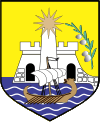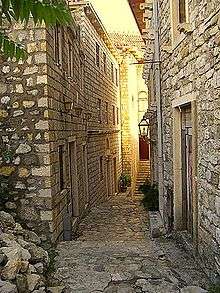Ulcinj
| Ulcinj | ||
|---|---|---|
| Town | ||
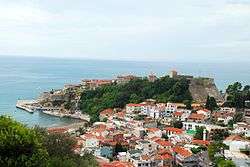 | ||
| ||
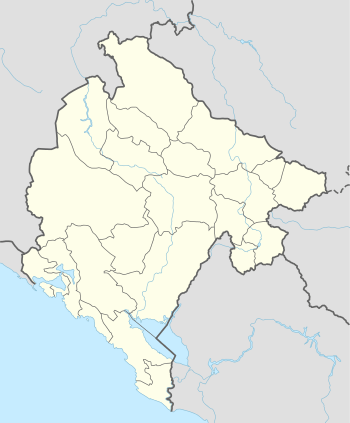 Ulcinj Location of Ulcinj | ||
| Coordinates: 41°55′N 19°12′E / 41.92°N 19.20°ECoordinates: 41°55′N 19°12′E / 41.92°N 19.20°E | ||
| Country | Montenegro | |
| Municipality | Ulcinj Municipality | |
| Settlements | 39 | |
| Government | ||
| • Mayor | Nazif Cungu | |
| • Ruling party | DPS - Forca - DP | |
| Area | ||
| • Total | 255 km2 (98 sq mi) | |
| Population (2011 census) | ||
| • Total | 10,828 | |
| • Density | 79.47/km2 (205.8/sq mi) | |
| • Municipality | 20,290 | |
| Demonym(s) |
Ulcinjani Ulqinakë | |
| Time zone | CET (UTC+1) | |
| • Summer (DST) | CEST (UTC+2) | |
| Postal code | 85360 | |
| Area code | +382 30 | |
| ISO 3166-2 code | ME-20 | |
| Car plates | UL | |
| Website | http://www.komunaeulqinit.com | |
Ulcinj (Montenegrin Cyrillic: Улцињ, pronounced [ǔlt͡siɲ]; Albanian: Ulqini) is a town on the southern coast of Montenegro and the capital of Ulcinj Municipality. It has an urban population of 10,707 (2011), the majority being Albanians.
As one of the oldest settlements in the Adriatic coast, it was founded in 5th century BC. It was captured by the Romans in 163 BC from the Illyrians. With the division of the Roman Empire, it became part of the Byzantine Empire. During Middle Ages it was under South Slavic rule for a few centuries. In 1405 it became part of Republic of Venice and in 1571 part of Ottoman Empire. Ulcinj was ceded to the Principality of Montenegro in 1880.
Ulcinj is a famous destination for tourists, because of its Long Beach, Lake Šas, Ada Bojana Island and for its two-millennia-old Ulcinj Castle. Ulcinj is also the centre of the Albanian community in Montenegro.
Name
Early historian Livy (59 BC–AD 17) mentioned it,[1] as did Pliny the Elder (23–79),[2] who mentioned it as Olcinium, its old name Colchinium, "founded by [settlers from] Colchis" (Olchinium quod antea Colchinium dictum est a Colchis conditum).[2] Ptolemy (90–168) mentions the city as Greek Oulkinion (Ουλκίνιον).[3] The name, through Late (Vulgar) Roman, became Slavic Ulcinj, Italian: Dulcigno (pronounced [dulˈtʃiɲɲo]) and Turkish: Ülgün.
Geography
Neighbourhoods
- Çarshia (mn. Čaršija), is a neighborhood and town centre which connects the old and new parts (neighbourhoods). In 2009 it was reconstructed, with the asphalt being changed into sett and the water and electrical system were changed. The neighbourhood has some 200 shops. It has an oriental atmosphere. There are two mosques located in this area, the Namazgjahu Mosque and Kryepazari Mosque.
- Pinješ
- Meterizi
- Meraja
- Mala Kolumbija
- Nova Mahala
- Potok
- Liman
- Pristan
History
Antiquity
Ulcinj is an ancient seaport.[4] The wider area of Ulcinj has been inhabited since the Bronze Age, based on dating of Illyrian tombs (tumuli) found in the village of Zogaj, in the vicinity of Ulcinj. The town is believed to have been founded in the 5th century BC by colonists from Colchis, as mentioned in the 3rd century BC poem by Apollonius of Rhodes. Illyrians lived in the region at the time as there are traces of immense Cyclopean walls still visible in the old Citadel.[4]
All the way in the pre-medieval period, Ulcinj was known as one of the pirate capitals of the Adriatic Sea. This is also seen during the later period of Illyrian Kingdom. Inhabitants of Ulcinj were known before time of Christ, especially from 20 BC to around 300 AD, to be very confrontational to those who were foreigners to their land; they were especially meticulous about border disputes as well.
Roman
In 163 BC, the Romans captured Colchinium and renamed the town Olcinium. Under Roman rule the town received the status of oppidum civium Romanorum (settlement of Roman citizens), only to be later granted municipium (independent town) status. A section of their re-fortification can be distinguished from the Illyrio-Greek by the rustication of the walls.[4]
After the division of the Roman Empire, Ulcinj became a part of the Byzantine province of Prevalis and the population converted to Christianity. From Medieval times, and quiet likely earlier, it was regarded as an important trading and maritime center and still maintained the status of city autonomy.[4]
Medieval period and South Slavic rule
In the 9th century, it was in the Dyrrhachium theme, of the Byzantine Empire. In 1010, Tsar Samuel of Bulgaria (r. 997-1014†) failed to conquer the town during the war against the Byzantines. By 1040, archon Stefan Vojislav of Duklja conquered the region. In 1183, Serbian Prince Stefan Nemanja conquered Olcinium and the town prospered as one of the most significant coastal towns. Ulcinj remained in Nemanjić hands in their Kingdom and Empire, and after the death of Emperor Dušan (r. 1331-1355†), the region, known as Lower Zeta, was under the supervision of gospodin Žarko, a voivode of Emperor Uroš the Weak until his death in 1360. Žarko's lands were then held by the Balšić family. Under Balšić control, Ulcinj continued to be an important town and also minted coins. The Balšić Tower in the upper part of the Old Town was built by the Montenegrins in the late 14th century.
Venetian and Ottoman rule
In 1405 the Venetians conquered the town. Under Venetian control, the city was renamed Dulcigno in Italian, and it was incorporated in the Albania Veneta. The Venetians maintained control until 1571, when the Ottoman Turks conquered Dulcigno with the help of Barbary pirates, who didn't leave the town after conquering. It remained within the Ottoman domain for over 300 years, during which time its far-reaching reputation as a lair of pirates was established.[4]
In the 17th century a self-proclaimed Jewish Messiah named Sabbatai Zevi caused turmoil throughout the Turkish Empire with his evangelizing, which attracted thousands of followers. He was eventually captured and exiled to Ulcinj in 1666, where he died quietly ten years later. He was buried in the courtyard of a Muslim house which is still preserved as a mausoleum; along with two Jewish alters in the Balšic Tower.[4]
In 1867, Ulcinj became a kaza of the İşkodra sanjak of Rumeli veyalet. After the Congress of Berlin in 1878, borders between Montenegro and the Ottoman Empire were redrawn, with Ulcinj becoming part of Montenegro. Although prepared to cede Plav, Gusinje and the villages of Grudë, Hoti and Kastrati, Turkey still wanted to retain Ulcinj. Despite resistance against this decision, Montenegro, supported by British Prime Minister Gladstone and others from western Europe, resisted and on 30 November 1880 the town became part of Montenegro.
Montenegrin independence referendum, 2006
During the 2006 referendum on Montenegro's independence, the Ulcinj municipality voted overwhelmingly to leave the State Union of Serbia and Montenegro. This was partly due to the region's large Albanian population. Other regions of Montenegro with large minority populations also voted in favor of independence.
Population
| Historical population | ||
|---|---|---|
| Year | Pop. | ±% |
| 1948 | 4,385 | — |
| 1953 | 4,919 | +12.2% |
| 1961 | 5,705 | +16.0% |
| 1971 | 7,459 | +30.7% |
| 1981 | 9,140 | +22.5% |
| 1991 | 10,025 | +9.7% |
| 2003 | 10,828 | +8.0% |
| 2011 | 10,707 | −1.1% |
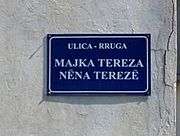
Ulcinj is the administrative centre of Ulcinj Municipality, which has a population of 19,921. The town of Ulcinj itself has a population of 10,707. Ulcinj Municipality is the centre of the Albanian community in Montenegro. It is the only municipality in Montenegro where Albanians form the majority with 60%.
|
|
Ethnicity, language and religion
The majority ethnic group in Ulcinj are Albanians. The largest spoken language is Albanian.
Population by ethnicity (2011 census):
Population by mother tongue (2011 census):
Population by religion (2011 census):
International relations
Twin towns – Sister cities
Ulcinj is twinned with:
Tourism
Ulcinj is a popular tourist destination in summer. In January 2010, the New York Times named ranked the south coast region of Montenegro, featuring Velika Plaza, Ada Bojana, and the Hotel Mediteran, as one of "The Top 31 Places to Go in 2010".[12]
Although still undiscovered by many travelers from larger countries, repeat tourists and an increasing amount of first time visitors make Ulcinj a hot spot for vacationers between the months of May and September. It is most famous for its sandy beaches, which are considered the most beautiful in Montenegro. The most valuable resource of the Ulcinj riviera is Velika plaža (Albanian: Plazha e Madhe, English: Long Beach), which is a 12 km (7.5 mi) long stretch of sandy beach and the longest beach on the Montenegrin coast. There is a small pebble beach called Ladies Beach which folk tradition holds to have qualities conducive to fertility. There is also a beach called Mala plaža (Albanian: Plazha e Vogël, English: Small Beach) which is much smaller in size, but is located in the centre of town and very popular with visitors. "The Korzo", as it is called by locals, is a promenade which separates a street lined with coffee shops from Mala plaža. At night during the summer months, the Korzo is pedestrianised and families and young people gather. There are many more less known smaller beaches that serve as get-aways from the main tourist areas. Ulcinj has also a large number of religious buildings like mosques, tyrbes and churches, including: Pasha's Mosque, Sailors' Mosque and St. Nicholas' Church.
Ulcinj's old town is a well preserved castle-looking community that is left over from medieval times. The old town sits atop a mountain overlooking the shore and is a tourist attraction on its own.
Ada Bojana (Albanian: Buna) is popular among foreign tourists from Western Europe for its peace and unique atmosphere. A large naturist campsite is located in Ada Bojana.[13]
Šaško lake and Ulcinj's salt pond are popular among birdwatchers, because Ulcinj and its surroundings are major resting points for over 200 bird species on their migration paths.
There are numerous cafés, discos, and bars that dot the city that are usually filled to capacity throughout the summer.
The majority of tourists that visit Ulcinj are Albanians (mostly from the United States), Serbians, Bosnians, Russians, Poles, Czechs and other Europeans.

Education
| Montenegrin name | Albanian name | Location | Language(s) |
|---|---|---|---|
| Elementary schools | |||
| Osnovna škola "Boško Strugar" | Shkolla Fillore "Boshko Strugar" | Ulcinj | Montenegrin & Albanian |
| Osnovna škola "Maršal Tito" | Shkolla Fillore "Marshal Tito" | Ulcinj | Montenegrin & Albanian |
| Osnovna škola "Bedri Elezaga" | Shkolla Fillore "Bedri Elezaga" | Vladimir | Albanian |
| Osnovna škola "Marko Nuculović" | Shkolla Fillore "Mark Nuculloviq" | Donji Štoj | Montenegrin & Albanian |
| High schools | |||
| Srednja mješovita škola "Bratstvo i jedinstvo" | Shkolla e Mesme e Kombinuar "Vëllazërim Bashkim" | Ulcinj | Montenegrin & Albanian |
| Gimnazija "Drita" | Gjimnazi "Drita" | Ulcinj | Albanian |
Sports and recreation
The Ulcinj "south coast" region is well known for its active sports, recreation possibilities and hunting . Kitesurfing at Ada Bojana, all manner of water sports at Velika plaža, scuba diving among wrecks and sunken cities, mountain biking, hiking, orienteering, cycling through the olive groves at Valdanos, long walks along the pristine beaches of the south coast of Montenegro, even deep sea fishing on the Adriatic, lake fishing at Lake Skadar, and river fishing in Ada Bojana, Due to the fact that the favorable habitat for wild life, has excellent conditions of hunting tourism.This place is the haven of omithological (gourmand) hunting in Reč and Shenkol most common wildlife are woodcock, Hare, Wild boar, and ducks. The beautiful attraction with flora and fauna in Ulcinj makes it an unforgettable journey in hunting activities..
List of sport clubs in Ulcinj:
| Name | Sport | Competing | Founded | |
|---|---|---|---|---|
| Montenegrin name | Albanian name | |||
| Fudbalski klub "Otrant" | Klubi Fudbolistik "Otrant" | Football | Montenegrin Second League | 1921 |
| Košarkaški klub "Ulcinj" | Klubi i Basketbollit "Ulcinj" | Basketball | Montenegrin Basketball League | 1976 |
| Rukometni klub "Ulcinj" | Klubi i Hendbollit "Ulcinj" | Handball | Montenegrin First League | |
| Teniski klub "Bellevue" | Klubi i Tenisit "Bellevue" | Tennis | 2009 | |
| Omladinski fudbalski klub "Federal" | Klubi Futbolistik Rinor "Federall" | Football | South Region League | 2007 |
| Karate klub "Champions" | Klubi i Karates "Champions" | Karate | ||
| Karate Klub "Ulcinj" | Klubi i Karates "Ulqini" | Karate | ||
| Stonoteniski Klub "Valdanos" | Klubi i Ping Pongut "Valdanos" | Table Tennis | Cadet,Junior,Senior Montenegrin League | 2012 |
Climate
Ulcinj has a Mediterranean climate (Köppen climate classification Csa), with mild, very rainy winters and hot, humid summers with afternoon thunder showers. Unlike Podgorica temperatures very rarely exceed 35 °C (95 °F) and seldom drop below 0 °C (32 °F).
| Climate data for Ulcinj, Montenegro | |||||||||||||
|---|---|---|---|---|---|---|---|---|---|---|---|---|---|
| Month | Jan | Feb | Mar | Apr | May | Jun | Jul | Aug | Sep | Oct | Nov | Dec | Year |
| Record high °C (°F) | 17.8 (64) |
20.0 (68) |
22.8 (73) |
25.0 (77) |
30.0 (86) |
33.9 (93) |
37.8 (100) |
40.0 (104) |
32.8 (91) |
28.9 (84) |
23.3 (73.9) |
18.9 (66) |
40.0 (104) |
| Average high °C (°F) | 11.2 (52.2) |
11.4 (52.5) |
14.6 (58.3) |
17.9 (64.2) |
22.1 (71.8) |
26.2 (79.2) |
29.2 (84.6) |
29.2 (84.6) |
26.1 (79) |
21.3 (70.3) |
16.1 (61) |
11.8 (53.2) |
19.76 (67.58) |
| Average low °C (°F) | 4.1 (39.4) |
4.7 (40.5) |
6.2 (43.2) |
10.1 (50.2) |
14.1 (57.4) |
17.7 (63.9) |
21.2 (70.2) |
21.1 (70) |
17.3 (63.1) |
13.1 (55.6) |
9.0 (48.2) |
4.6 (40.3) |
11.93 (53.5) |
| Record low °C (°F) | −7.8 (18) |
−6.1 (21) |
−3.0 (26.6) |
3.9 (39) |
6.7 (44.1) |
10.0 (50) |
13.1 (55.6) |
13.3 (55.9) |
9.8 (49.6) |
6.1 (43) |
−1.1 (30) |
−5.3 (22.5) |
−7.8 (18) |
| Average precipitation mm (inches) | 149 (5.87) |
138 (5.43) |
116 (4.57) |
115 (4.53) |
67 (2.64) |
46 (1.81) |
25 (0.98) |
49 (1.93) |
85 (3.35) |
148 (5.83) |
174 (6.85) |
146 (5.75) |
1,258 (49.54) |
| Average precipitation days (≥ 0.1 mm) | 12.3 | 12.1 | 11.8 | 11.8 | 8.2 | 6.7 | 3.8 | 4.3 | 6.6 | 9.7 | 12.8 | 12.4 | 112.5 |
| Mean monthly sunshine hours | 124.0 | 127.1 | 170.5 | 204.0 | 269.7 | 297.0 | 350.3 | 322.4 | 252.0 | 198.4 | 132.0 | 114.7 | 2,562.1 |
| Source: Hydrological and Meteorological Service of Montenegro[14] | |||||||||||||
Transport
Ulcinj is connected with the rest of Montenegro by two-lane highway. It is connected with other coastal towns by the Adriatic Motorway. Reaching inland is made possible by detouring from the Adriatic Motorway at Budva or Sutomore (through the Sozina tunnel).
As of today, there are no airports in the city of Ulcinj. However, nearby airports in Tivat and Podgorica are both around 70 km (43 mi) away. There are regular flights to Belgrade and Zürich from Tivat. Podgorica Airport has regular flights to major European destinations throughout the year. Many tourists traveling to Ulcinj from abroad arrive to the city from the airport in Tivat due to its recent renovations and general ease of navigation.
People
Notable people who lived in Ulcinj or its surroundings:
- Miguel de Cervantes, Spanish writer
- Đurađ II Balšić, Lord of Zeta from 1385 to 1403, member of the Balšić noble family.
- Jelena Balšić, Serbian noblewoman of Lazarević dynasty, author of Gorički zbornik, first woman writer in South Slavs
- Gjon Buzuku, Catholic priest who wrote the first known printed book in Albanian
- Pjetër Gjoka, actor and People's Artist of Albania
- Gasparo Bruni, Knight of the Order of Malta (16th Century), Fought in the Battle of Lepanto (1571)
- John VIII or Giovanni Bruni, archbishop of Bar, 1551-1571
- Adrian Lulgjuraj, singer
- Ndoc Martini, painter
- Alex Rudaj, Albanian-American mobster
- Likaceni, Captain and Pirate Commander
- Kaplan Burović, dissident, poet, Albanologist
- Rade Tovladijac, Serbian comic book artist
- Mujo Ulqinaku, Albanian officer and a People's Hero of Albania
- Sabbatai Zevi, İzmir born mystic, founder of the Jewish Sabbatean movement
- Andrej Nikolaidis, Montenegrin writer
- Cafo Beg Ulqini, Leader of Second League of Prizren and Knight in the Order of Skandebeg[15]
- Božidar Đurašković, Montenegrin athlete, gold medal winner at Mediterranean Games
- Vladimir Mihailović, Montenegrin basketball national team player
See also
- Albanians in Montenegro
- List of mayors of Ulcinj
- List of mosques in Ulcinj
- Tourism in Montenegro
- Ulcinj Airport
- Ulcinj Municipality
 |
Bar Municipality |
Bar Municipality |
Shkodër County |
 |
| Adriatic Sea | |
Shkodër County | ||
| ||||
| | ||||
| Adriatic Sea | Adriatic Sea | Shkodër County |
 |
Bijela Gora | Bratica | Kodre |  |
| Adriatic Sea | |
Kodre | ||
| ||||
| | ||||
| Adriatic Sea | Adriatic Sea | Donji Štoj |
Notes
- ↑ Pavle Mijović (1970). Tragom drevnih kultura Crne Gore. Grafički zavod. p. 35.
- 1 2 C. Praschniker; A. Schober (1976). Arch?ologische Forschungen in Albanien und Montenegro. Рипол Классик. pp. 82–. ISBN 978-5-87379-103-3.
- ↑ "16". Claudii Ptolemaei Geographia edidit Carolus Fridericus Augustus Nobbe. 1. sumptibus et typis Caroli Tauchnitii. 1843. p. 134.
- 1 2 3 4 5 6 Rellie, Annalisa (2012). Montenegro. Bradt Travel Guides Ltd, IDC House, The Vale, Chalfront St Peter, Bucks SL9 9RZ, England: The Globe Pequot Press Inc. pp. 207–208. ISBN 978 1 84162 381 8. Retrieved 2013-06-20.
- 1 2 3 4 5 Bratimljenje gradova Crne Gore
- ↑ Bezirkspartnerschaften der Stadt Wien
- ↑ “Bratimljenje” Lukavca i Ulcinja od posebne važnosti za privrednu saradnju
- ↑ POTPISAN SPORAZUM O SARADNJI OPŠTINA/OPĆINA ULCINJ I STARI GRAD SARAJEVO
- ↑ Vizita: NESËR BINJAKËZIMI I ULQINIT DHE SERIKUT
- ↑ Ulcinj’li yeni kardeşler Serik’ten memnun kaldı
- ↑ Ceremonia në Serik: NËNSHKRUHET PROTOKOLLI PËR BINJAKËZIM
- ↑ Williams, Gisela (7 January 2010). "The 31 Places to Go in 2010: 24. Montenegro". New York Times.
- ↑ ulcinj.com staff (August 2009). "The Nudist Camping,Ada bojana,Naturist auto camp,Montenegro". www.visit-ulcinj.com. Retrieved July 2012. Check date values in:
|access-date=(help) - ↑ "Climatology". Hydrological and Meteorological Service of Montenegro. Retrieved 2012-10-13.
- ↑ http://www.visit-ulcinj.com/blog/2016/04/20/nishani-dekoron-cafo-beg-ulqinin-titullin-kalores-urdhrit-te-skenderbeut/
References
- Istorija Ulcinja. Balkan. 2009.
- Istorija i poreklo stanovništva Ulcinja i njegovih sela. Institut za poljoprivredu. 1990.
- Maksud Hadžibrahimović; Ismet Kalezić; Miodrag Mirović; Mileva Nikolaidis, Abaz Rečica (1989). Ulcinj. Tourist Alliance of the Commune. ISBN 978-86-7133-141-8. Cite uses deprecated parameter
|coauthors=(help)  Chisholm, Hugh, ed. (1911). "Dulcigno". Encyclopædia Britannica. 8 (11th ed.). Cambridge University Press. p. 652.
Chisholm, Hugh, ed. (1911). "Dulcigno". Encyclopædia Britannica. 8 (11th ed.). Cambridge University Press. p. 652.- World Climate staff (2011). "WorldClimate: Ulcinj". Retrieved July 2012. Check date values in:
|access-date=(help)
External links
| Wikimedia Commons has media related to Ulcinj. |
| Wikivoyage has a travel guide for Ulcinj. |
- "Travel Guide Ulcinj". Retrieved July 2012. Check date values in:
|access-date=(help) - "Visit Ulcinj Tourism Official Guide". Retrieved July 2012. Check date values in:
|access-date=(help)
